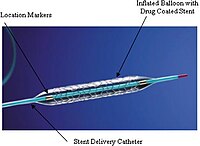
Photo from wikipedia
April 23, 2019 2081 Rafael Romaguera, MD Josep Gomez-Lara, MD, PhD Joan Antoni GomezHospital, MD, PhD To the Editor: We read with great interest the meta-analysis by Bangalore et al1… Click to show full abstract
April 23, 2019 2081 Rafael Romaguera, MD Josep Gomez-Lara, MD, PhD Joan Antoni GomezHospital, MD, PhD To the Editor: We read with great interest the meta-analysis by Bangalore et al1 comparing ultrathin strut drug-eluting stents (DES) versus older second-generation thicker strut DES for coronary artery disease. The results of this study suggest that ultrathin strut DES reduce stent thrombosis, myocardial infarction, and consequently target-vessel failure compared with older second-generation DES. Because these conclusions will be of tremendous impact to the interventional community, we believe that clarifying some methodological issues would be of scientific interest. First, an ultrathin strut DES was defined in the article as strut thickness <70 μm, and 3 DES platforms with different polymer thickness and composition were included: Orsiro (Biotronik, Berlin, Germany), MiStent (Stentys, Saint-Denis, France), and BioMime (Meril, Vapi, India). However, Orsiro (which was used in 8 of the 10 studies included in the meta-analysis) has a 60-μm strut thickness (plus 11 μm of polymer) only for the smaller stents, having an 80+11 μm platform for stents ≥3.5 mm. Considering that, for example, in the BIOSCIENCE trial2 (the trial with the greatest weight in the present meta-analysis), the mean stent diameter for Orsiro was 3.05±0.49 mm, a significant proportion of stents included in the ultrathin strut group would be using the 80+11 μm platform and therefore would be a thick-strut DES as defined in the article. Thus, the ultrathin strut group actually included many thick-strut stents. Second, the authors included the Nobori stent (Terumo, Japan) in the control group. This device is a stainless steel rather than cobalt chromium stent with 120μm strut thickness (plus 10 μm of polymer). Notably, many myocardial infarctions and stent thromboses in the control group came from this device. Although we recognize the effort of the authors in performing meta-regression and sensitivity analyses, we wonder about the appropriateness of including a stainless steel stent that is not even commercialized in Europe or the United States on the same team as the current everolimusor zotarolimus-eluting stents. Third, and importantly, the present meta-analysis counted 6 of 86 target-lesion failure events (7.14%) in the everolimus-eluting stent group from the MeriT-V trial.3 However, half of these events (3 of 86 [3.49%]) were not target-vessel myocardial infarctions, and thus, the real target-vessel failure rate should have been 3.49% (3 of 86), whereas the reported 7.14% corresponded to major adverse cardiovascular events. Similarly, both target-vessel and non–target-vessel myocardial infarctions were counted in the myocardial infarction secondary end point in the control group. Finally, a recent investigator-initiated randomized study (the BIONYX trial [Biosorbable Polymer ORSIRO Versus Durable Polymer RESOLUTE ONYX Stents])4 has shown that the 60to 80-μm thin-strut Orsiro is associated with a © 2019 American Heart Association, Inc. LETTER TO THE EDITOR
Journal Title: Circulation
Year Published: 2019
Link to full text (if available)
Share on Social Media: Sign Up to like & get
recommendations!